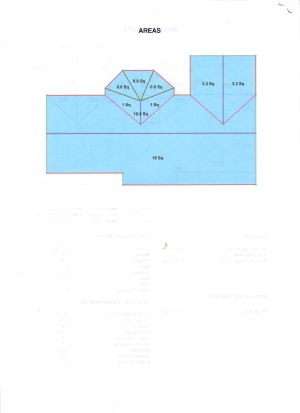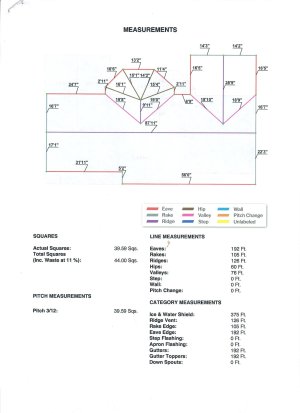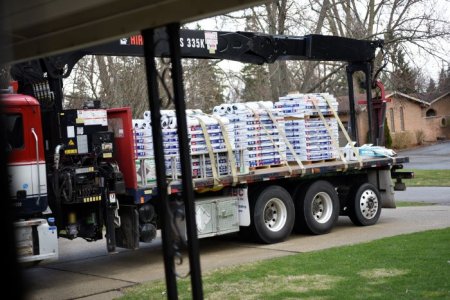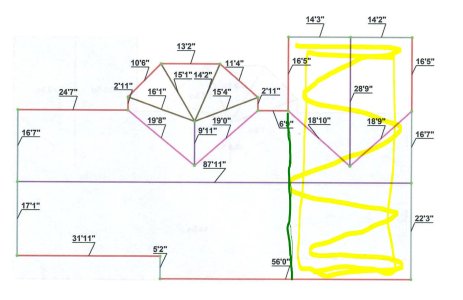You are using an out of date browser. It may not display this or other websites correctly.
You should upgrade or use an alternative browser.
You should upgrade or use an alternative browser.
Another Roofing Thread...
- Thread starter grr456
- Start date
4Gas$
Club Member
Just had a roof done 40 squares 7 skylights and new gutters 30k and first good hard rain I had a drip they say they "missed caulk" around a skylight
tittle brothers
But how did they do on the repair?
To me the sin isn't doing something wrong,
but how well you take care of it.
I had a similar problem with Roofman. They were
at my house fixing it within 2 hours of my call.
Great service, great response, hence, they get my
recommendation.
My roof was replaced 3 years ago and the cost was
under $9,000.
Maybe look into Erie metal roofing. Guy down the street had them do theirs. Comparable $$$ to asphalt shingles, 50 year warranty, 2 days, looks like regular shingles.
Hahahaha.....Yeah, metal roofs are comparable in price...Comparable to what????
Erie - 46k for a re-shingle without tear off and 51k with tear off - Close to double that for a metal roof! *Gasp*<gasp>
Mr Roof - 10k for a re-shingle and 19k with tear-off.....
Marrs is coming out in a few days.....
EDIT: Don't ever call Erie - Talk about high pressure, holy smokes....Haven't seen high pressure sales like that since the 70's and Time Share salesmen...</gasp>
Last edited:
4Gas$
Club Member
Hahahaha.....Yeah, metal roofs are comparable in price...Comparable to what????
Erie - 46k for a re-shingle without tear off and 51k with tear off - Close to double that for a metal roof! *Gasp*<gasp>
Mr Roof - 10k for a re-shingle and 19k with tear-off.....
Marrs is coming out in a few days.....
EDIT: Don't ever call Erie - Talk about high pressure, holy smokes....Haven't seen high pressure sales like that since the 70's and Time Share salesmen...</gasp>
Sounds like Hanson's.
Siegel1719
Club Member
Just had a roof done 40 squares 7 skylights and new gutters 30k and first good hard rain I had a drip they say they "missed caulk" around a skylight
tittle brothers
Now that's concerning. Caulk has very little business on a roof. Much less preventing a leak at a skylight. The skylights should be flashed properly which keeps water out and that is permanent not caulking that may last 15-20 years.
camaromann
Forum Member
Now that's concerning. Caulk has very little business on a roof. Much less preventing a leak at a skylight. The skylights should be flashed properly which keeps water out and that is permanent not caulking that may last 15-20 years.
I agree. I’ve installed skylights on metal roofs and shingled roofs when I was younger. There was never anything really to caulk. It’s all contained and covered/overlapping 3 times and shouldn’t need any caulk.
wrath
Club Member
You have a gravy roof job.
$33 street price for a bundle of GAF's best shingles. Or around $1 sqft.
Ridge cap is about $1/linear foot.
Synthetic underlayment is $.10 sqft or $85/1000sqft.
Iceguard is about $1/linear foot.
$50 buys you enough washered nails to hold down all the synthetic underlayment.
A case of synthetic glue/sealer (UV-treated polyurethane) is $80.
Drip edge is around $.75/linear foot.
New cans or new ridge vent are about the same price, around $150 for the size of your roof.
Pay someone to inspect your roof (not just fly a drone or say "looks like you need a roof" from the driveway). We have a recession coming. These people will be begging to show up for half price 4 months after the recession starts.
A fat middle-aged office worker like myself can tear off and re-shingle about 4 square per day.
I'd never add another layer to a roof on a house I'd be staying in. Now you've got twice as many nails fighting to poke holes in your shingles and twice as much weight on your roof. Twice as much heat mass.
$33 street price for a bundle of GAF's best shingles. Or around $1 sqft.
Ridge cap is about $1/linear foot.
Synthetic underlayment is $.10 sqft or $85/1000sqft.
Iceguard is about $1/linear foot.
$50 buys you enough washered nails to hold down all the synthetic underlayment.
A case of synthetic glue/sealer (UV-treated polyurethane) is $80.
Drip edge is around $.75/linear foot.
New cans or new ridge vent are about the same price, around $150 for the size of your roof.
Pay someone to inspect your roof (not just fly a drone or say "looks like you need a roof" from the driveway). We have a recession coming. These people will be begging to show up for half price 4 months after the recession starts.
A fat middle-aged office worker like myself can tear off and re-shingle about 4 square per day.
I'd never add another layer to a roof on a house I'd be staying in. Now you've got twice as many nails fighting to poke holes in your shingles and twice as much weight on your roof. Twice as much heat mass.
ultradriver10000
Forum Member
I'd never add another layer to a roof on a house I'd be staying in. Now you've got twice as many nails fighting to poke holes in your shingles and twice as much weight on your roof. Twice as much heat mass.
This is what I'm most interested in.
So I know ridge vents and flashing can get tricky when doing multiple layers, but I'm really curious why there are so many people that say its a hard no. As far as the nails go, its only more nails through the first layer which still has some level of tar in them... so it should have some level of sealing right? It can't be any worse then the top new layer, except for when both layer need to be removed eventually.
Weight shouldn't matter, roofs are rated for snow load which will be way more then another layer of shingles.
Heat mass, now that is a curious one. Here in Mi where we have more cold weather then warm weather, I might even consider this a benefit. Being that the shingles are dark and add energy to your house, it would probably be helpful ~9 months out of the year no?
To be clear I'm not for or against, I've just never really seen anything that supported one way or the other with much evidence. I'm interested to hear more from others that have done it.
wrath
Club Member
Nails usually lift, especially with time, especially on shittier wood (like OSB). You're entirely depending on someone to hit the nail strip every time and seal every hole that the head doesn't seal on that strip. Most don't give a fuck and I've seen "professionals" leave bare nails below the strip but above the reveal... where there is a seam on the course above.
Next layer of shingles gives you a better chance of hitting another obstruction (like another nail) especially since shingles are usually the same size every time. Switching from 3 tab to metric dimensional can help with that. But again, lazy roofers are more than likely going to leave a hole.
If you don't strip the deck, you will never know if you have any damage.
If you don't strip the deck, all roof penetrations are largely going to depend on sealer. No one is going to bother doing a good job. They're just laying down product and dabbing on minimal sealer.
A bundle of shingles is not free weight. Most roofs are rated for at most 40lb/sqft.
Shingles depend on cooling being provided by the roof vents. If there are two layers of shingles they can't get rid of heat as well. You want everything above your insulation to be ambient temperature year round.
The hard part of roofing are the houses with a lot of roof lines like was popular from the late 80s through the late 90s. The ticky tacky boxes built since usually have the most simple roof lines because they usually are even missing a bunch of penetrations (everything vents through wall except maybe a soil stack or two) and everyone was too cheap to pay for dormers let alone elaborate roof lines with lots of ridges and valleys.
Stripping the roof of shingles should cost you:
$300 per pallet of shingles for disposal. A pallet of shingles is usually 36, 39, or 42 bundles.
The labor to strip the roof. Not rocket science here, one person can do a pallet worth per day with plenty of siesta time.
The materials and labor to put down more felt (synthetic or tar paper). Nailing the synthetic by hand will cost a lot more than stapling tar paper, but the material costs the same.
Next layer of shingles gives you a better chance of hitting another obstruction (like another nail) especially since shingles are usually the same size every time. Switching from 3 tab to metric dimensional can help with that. But again, lazy roofers are more than likely going to leave a hole.
If you don't strip the deck, you will never know if you have any damage.
If you don't strip the deck, all roof penetrations are largely going to depend on sealer. No one is going to bother doing a good job. They're just laying down product and dabbing on minimal sealer.
A bundle of shingles is not free weight. Most roofs are rated for at most 40lb/sqft.
Shingles depend on cooling being provided by the roof vents. If there are two layers of shingles they can't get rid of heat as well. You want everything above your insulation to be ambient temperature year round.
The hard part of roofing are the houses with a lot of roof lines like was popular from the late 80s through the late 90s. The ticky tacky boxes built since usually have the most simple roof lines because they usually are even missing a bunch of penetrations (everything vents through wall except maybe a soil stack or two) and everyone was too cheap to pay for dormers let alone elaborate roof lines with lots of ridges and valleys.
Stripping the roof of shingles should cost you:
$300 per pallet of shingles for disposal. A pallet of shingles is usually 36, 39, or 42 bundles.
The labor to strip the roof. Not rocket science here, one person can do a pallet worth per day with plenty of siesta time.
The materials and labor to put down more felt (synthetic or tar paper). Nailing the synthetic by hand will cost a lot more than stapling tar paper, but the material costs the same.
moneypit
Club Member
Now that's concerning. Caulk has very little business on a roof. Much less preventing a leak at a skylight. The skylights should be flashed properly which keeps water out and that is permanent not caulking that may last 15-20 years.
I havent gone up and looked yet once its a little warmer ill go take a look
ultradriver10000
Forum Member
Nails usually lift, especially with time, especially on shittier wood (like OSB). You're entirely depending on someone to hit the nail strip every time and seal every hole that the head doesn't seal on that strip. Most don't give a fuck and I've seen "professionals" leave bare nails below the strip but above the reveal... where there is a seam on the course above.
Next layer of shingles gives you a better chance of hitting another obstruction (like another nail) especially since shingles are usually the same size every time. Switching from 3 tab to metric dimensional can help with that. But again, lazy roofers are more than likely going to leave a hole.
If you don't strip the deck, you will never know if you have any damage.
If you don't strip the deck, all roof penetrations are largely going to depend on sealer. No one is going to bother doing a good job. They're just laying down product and dabbing on minimal sealer.
A bundle of shingles is not free weight. Most roofs are rated for at most 40lb/sqft.
Shingles depend on cooling being provided by the roof vents. If there are two layers of shingles they can't get rid of heat as well. You want everything above your insulation to be ambient temperature year round.
The hard part of roofing are the houses with a lot of roof lines like was popular from the late 80s through the late 90s. The ticky tacky boxes built since usually have the most simple roof lines because they usually are even missing a bunch of penetrations (everything vents through wall except maybe a soil stack or two) and everyone was too cheap to pay for dormers let alone elaborate roof lines with lots of ridges and valleys.
Stripping the roof of shingles should cost you:
$300 per pallet of shingles for disposal. A pallet of shingles is usually 36, 39, or 42 bundles.
The labor to strip the roof. Not rocket science here, one person can do a pallet worth per day with plenty of siesta time.
The materials and labor to put down more felt (synthetic or tar paper). Nailing the synthetic by hand will cost a lot more than stapling tar paper, but the material costs the same.
Awesome!! Thanks
derbydad276
Club Member
Ok ... time to chime in with my two cents worth...
I'm having my roof done today ... 18 Sq... lucky for me my nephew works for the roofing contractor... So I'm getting the family discount ...
They assured me that if anyone else called them they would beat Mr Roof , Tittle Bros, Hanson's , Victor's ....Ect.
Measured my roof using Google Earth ! according to them , they are able to measure within inches... go figure...
if you have a home Downriver ... Dearborn, Dearborn Heights ,Allen park , Taylor, Trenton, Wyandotte, Lincoln Park, Riverview, Grosse Isle, Gibraltar, ... they also serve Monroe county
Napier's Home Improvement
19287 Allen rd. Brownstown
313-291-0747 or 734-676-6557
even though I'm (family) they still provided me with their referral book over 100 pages worth ! a copy of their insurance , builders license , certification's from manufacturers and pulled a permit
they also do seamless gutters and siding
I'm having my roof done today ... 18 Sq... lucky for me my nephew works for the roofing contractor... So I'm getting the family discount ...
They assured me that if anyone else called them they would beat Mr Roof , Tittle Bros, Hanson's , Victor's ....Ect.
Measured my roof using Google Earth ! according to them , they are able to measure within inches... go figure...
if you have a home Downriver ... Dearborn, Dearborn Heights ,Allen park , Taylor, Trenton, Wyandotte, Lincoln Park, Riverview, Grosse Isle, Gibraltar, ... they also serve Monroe county
Napier's Home Improvement
19287 Allen rd. Brownstown
313-291-0747 or 734-676-6557
even though I'm (family) they still provided me with their referral book over 100 pages worth ! a copy of their insurance , builders license , certification's from manufacturers and pulled a permit
they also do seamless gutters and siding
Last edited:
wickettoby1
Forum Member
Please elaborate on how you used google to measure you’re roof?
mustangmike6996
Club Member
Please elaborate on how you used google to measure you’re roof?
Maps and Earth have a measurement tool. Earth calculates out the area of the shape drawn too.
mustangjoe87
Forum Member
Please elaborate on how you used google to measure you’re roof?
This is actually really common and more accurate than you'd think. There are also companies that take the images and put an entire report together with all measurements, pitches, etc. You can have the estimate written before you even arrive.
derbydad276
Club Member
This is actually really common and more accurate than you'd think. There are also companies that take the images and put an entire report together with all measurements, pitches, etc. You can have the estimate written before you even arrive.
yup this is what they did ... IDK how it works ...they delivered 18 sq... had 1.5 bundles left when they were done ... 8 man crew ...
got to my house ant 9 am pulled away at 6 pm ... took a 1 hour lunch break
2 layer tear off ... misc. plywood / facia repair work ... Ice and Snow guard 6 ft. up and along wall of attached garage
All of the quotes except for Oakes, Victors and Erie were between 17.5k and 20k - Oakes is 14.5k and both Victors and Erie were over 45k!
I am going with Oakes because they are the cheapest, but seem to be reputable with no hits on the BBB and a bunch of positive reviews. They also gave me a book with at least 200 references. Oakes also gave me a break due to Military and I played my current cancer sympathy and senior card...But, I am once again cancer free since I had surgery #8 in Jan. First time I ever tried to get a discount on anything...
Got something similar from most of the companies. The guy from Victors didn't even go up on the roof, but everyone else went up to do a confirmation of the measurements.
Not sure which or both maps below are from Google...



I am going with Oakes because they are the cheapest, but seem to be reputable with no hits on the BBB and a bunch of positive reviews. They also gave me a book with at least 200 references. Oakes also gave me a break due to Military and I played my current cancer sympathy and senior card...But, I am once again cancer free since I had surgery #8 in Jan. First time I ever tried to get a discount on anything...
Got something similar from most of the companies. The guy from Victors didn't even go up on the roof, but everyone else went up to do a confirmation of the measurements.
Not sure which or both maps below are from Google...



dave89iroc
Club Member
damn, nice sized garage

